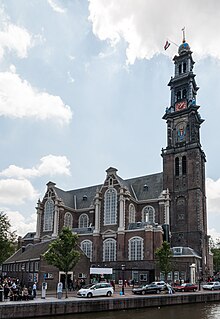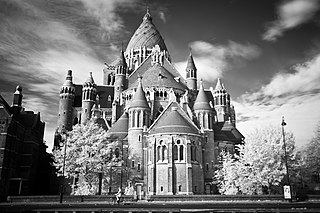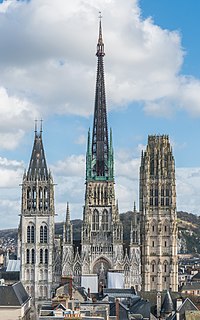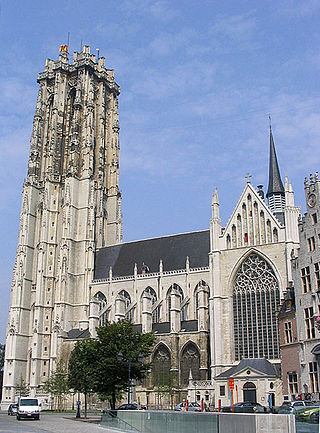
A carillon ( KERR-ə-lon, kə-RIL-yən) is a pitched percussion instrument that is played with a keyboard and consists of at least 23 cast-bronze bells. The bells are hung in fixed suspension and tuned in chromatic order so that they can be sounded harmoniously together. They are struck with clappers connected to a keyboard of wooden batons played with the hands and pedals played with the feet. Often housed in bell towers, carillons are usually owned by churches, universities, or municipalities. They can include an automatic system through which the time is announced and simple tunes are played throughout the day.

The Westerkerk is a Reformed church within Dutch Protestant Calvinism in central Amsterdam, Netherlands. It lies in the most western part of the Grachtengordel neighborhood, next to the Jordaan, between the Prinsengracht and Keizersgracht.

The Grote Kerk or St.-Bavokerk is a Reformed Protestant church and former Catholic cathedral located on the central market square in the Dutch city of Haarlem. Another Haarlem church called the Cathedral of Saint Bavo now serves as the main cathedral for the Roman Catholic Diocese of Haarlem-Amsterdam.

The Basilica di Santa Maria Gloriosa dei Frari, usually just called the Frari, is a church located in the Campo dei Frari at the heart of the San Polo district of Venice, Italy. The largest church in the city, it has the status of a minor basilica. The church is dedicated to the Assumption of Mary.

Ulm Minster is a Lutheran church located in Ulm, State of Baden-Württemberg (Germany). It is currently the tallest church in the world. The church is the fifth-tallest structure built before the 20th century, with a steeple measuring 161.5 metres (530 ft).

The Peter and Paul Cathedral is a Russian Orthodox cathedral located inside the Peter and Paul Fortress in St. Petersburg, Russia. It is the first and oldest landmark in St. Petersburg, built between 1712 and 1733 on Hare Island along the Neva River. Both the cathedral and the fortress were originally built under Peter the Great and designed by Domenico Trezzini. The cathedral's bell tower is the world's tallest Orthodox bell tower. Since the belfry is not standalone, but an integral part of the main building, the cathedral is sometimes considered the highest Orthodox Church in the world. There is another Cathedral of Saints Peter and Paul Church in St. Petersburg, located in Petergof.

The Cathedral Church and Minor Basilica of Saint Patrick is the cathedral church of the Roman Catholic Archdiocese of Melbourne in Victoria, Australia, and seat of its archbishop, currently Peter Comensoli.

The Cathedral of St. Michael and St. Gudula, usually shortened to the Cathedral of St. Gudula or St. Gudula by locals, is a medieval Roman Catholic cathedral in central Brussels, Belgium. It is dedicated to Saint Michael and Saint Gudula, the patron saints of the City of Brussels, and is considered to be one of the finest examples of Brabantine Gothic architecture.

The Cathedral of Saint Bavo is a cathedral in Haarlem, the Netherlands, built by Joseph Cuypers from 1895 to 1930 to replace the former waterstaatskerk in the Jansstraat called the St. Joseph. That church was itself a replacement for the Sint-Bavokerk, that had been converted to Protestantism from Catholicism in 1578. The Cathedral of Saint Bavo now serves as the main cathedral for the Roman Catholic Diocese of Haarlem-Amsterdam. Within the cathedral, the former sacristy has been converted into a small museum (schatkamer) containing historical artefacts from Haarlem's Catholic past.

Rouen Cathedral is a Roman Catholic church in Rouen, Normandy, France. It is the see of the Archbishop of Rouen, Primate of Normandy. It is famous for its three towers, each in a different style. The cathedral, built and rebuilt over a period of more than eight hundred years, has features from Early Gothic to late Flamboyant and Renaissance architecture. It also has a place in art history as the subject of a series of impressionist paintings by Claude Monet.

The Basilica of the Sacred Heart in Notre Dame, Indiana, is a Catholic church on the campus of the University of Notre Dame, also serving as the mother church of the Congregation of Holy Cross (C.S.C.) in the United States. The neo-gothic church has 44 large stained glass windows and murals completed over a 17-year period by the Vatican painter Luigi Gregori. The basilica bell tower is 230 feet (70 m) high, making it the tallest university chapel in America. It is a contributing building in Notre Dame's historic district listed on the National Register of Historic Places. The basilica is a major tourist attraction in Northern Indiana, and is visited annually by more than 100,000 tourists.

Pieter Hemony and his brother François Hemony were the greatest bellfounders in the history of the Low Countries. They developed the carillon, in collaboration with Jacob van Eyck, into a full-fledged musical instrument by casting the first tuned carillon in 1644.

Bordeaux Cathedral, officially known as the Primatial Cathedral of St Andrew of Bordeaux, is a Roman Catholic church dedicated to Saint Andrew and located in Bordeaux, France. It is the seat of the Archbishop of Bordeaux.

The Basilica of Saint Servatius is a Roman Catholic church dedicated to Saint Servatius, in the city of Maastricht, the Netherlands. The architecturally hybrid but mainly Romanesque church is situated next to the Gothic church of Saint John, backing onto the town's main square, Vrijthof.

The Basilica of Our Lady is a Romanesque church in the historic center of Maastricht, Netherlands. The church is dedicated to Our Lady of the Assumption and is a Roman Catholic parish church in the Diocese of Roermond. The church is often referred to as the Star of the Sea, after the church's main devotion, Our Lady, Star of the Sea.

Brabantine Gothic, occasionally called Brabantian Gothic, is a significant variant of Gothic architecture that is typical for the Low Countries. It surfaced in the first half of the 14th century at St. Rumbold's Cathedral in the City of Mechelen.

The Waag building is a National monument (Rijksmonument) listed building on the Waagplein in Alkmaar in the Netherlands. On this square Waagplein every Friday from April till the second week of September, the famous cheese market is held. The Dutch Cheese Museum and the tourist information Office (VVV) are also in the building. In the tower is a famous carillon weekly played by a carillonneur and also automatically by a drum chiming the quarters of the hour. There is also the famous automatic horse with knights play in the tower with an automatic trumpetplayer.

The City Church of Biel is a Swiss Reformed church in Biel/Bienne, Switzerland. Built in the Gothic style, its construction started around 1451 and was mostly complete in 1470. The church is considered one of the most significant late-Gothic churches in Switzerland and is a Swiss Cultural Property of National Significance.

The Gerardus Majellakerk is a Roman Catholic church located in southern Tilburg along the Wassenaerlaan. It is dedicated to Gerard Majella, who became a saint in 1904, and has been part of the parish De Goede Herder since its inception in 2012.

The Liebfrauenkirche in the Thuringian town of Arnstadt, Germany, is a Lutheran parish church. The basilica, which was essentially erected in the 12th and 13th centuries, is considered, along with Naumburg Cathedral, to be the most important church building of the transitional phase from Romanesque to Gothic architecture in Thuringia.
























